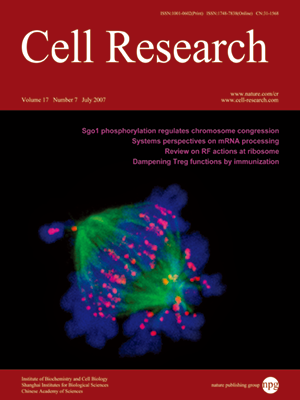
Volume 17, No 7, Jul 2007
ISSN: 1001-0602
EISSN: 1748-7838 2018
impact factor 17.848*
(Clarivate Analytics, 2019)
Volume 17 Issue 7, July 2007: 591-607
REVIEWS
Accommodating the bacterial decoding release factor as an alien protein among the RNAs at the active site of the ribosome
Elizabeth S Poole, David J Young, Marjan E Askarian-Amiri, Debbie-Jane G Scarlett and Warren P Tate
Department of Biochemistry, University of Otago, P.O. Box 56, Dunedin, New Zealand
Correspondence: Warren P Tate(warren.tate@stonebow.otago.ac.nz)
The decoding release factor (RF) triggers termination of protein synthesis by functionally mimicking a tRNA to span the decoding centre and the peptidyl transferase centre (PTC) of the ribosome. Structurally, it must fit into a site crafted for a tRNA and surrounded by five other RNAs, namely the adjacent peptidyl tRNA carrying the completed polypeptide, the mRNA and the three rRNAs. This is achieved by extending a structural domain from the body of the protein that results in a critical conformational change allowing it to contact the PTC. A structural model of the bacterial termination complex with the accommodated RF shows that it makes close contact with the first, second and third bases of the stop codon in the mRNA with two separate loops of structure: the anticodon loop and the loop at the tip of helix 5. The anticodon loop also makes contact with the base following the stop codon that is known to strongly influence termination efficiency. It confirms the close contact of domain 3 of the protein with the key RNA structures of the PTC. The mRNA signal for termination includes sequences upstream as well as downstream of the stop codon, and this may reflect structural restrictions for specific combinations of tRNA and RF to be bound onto the ribosome together. An unbiased SELEX approach has been investigated as a tool to identify potential rRNA-binding contacts of the bacterial RF in its different binding conformations within the active centre of the ribosome.
Cell Research (2007) 17:591-607. doi: 10.1038/cr.2007.56; published online 10 July 2007
FULL TEXT | PDF
Browse 1838


